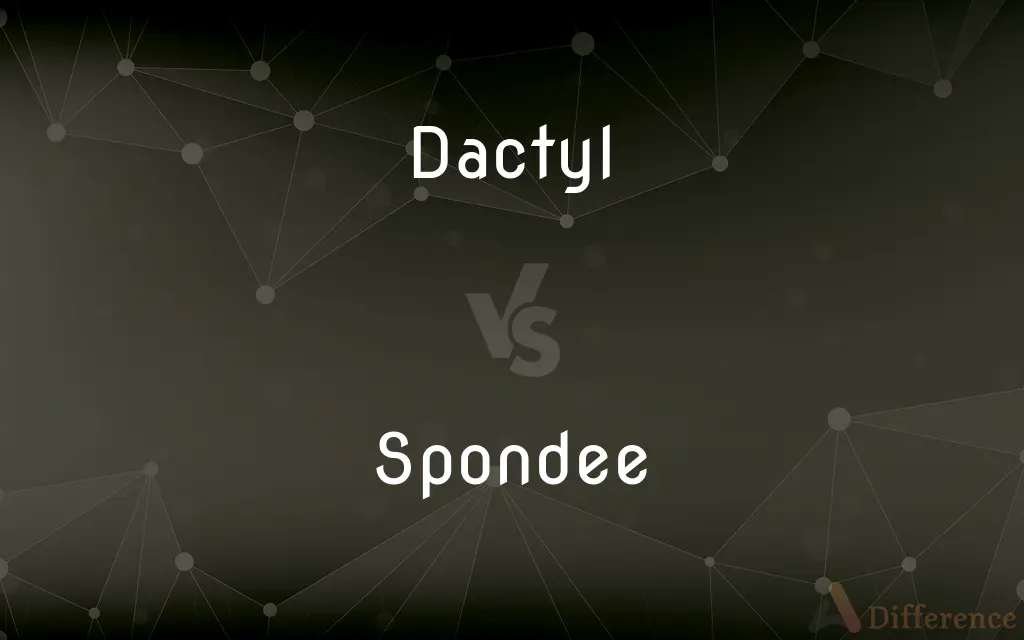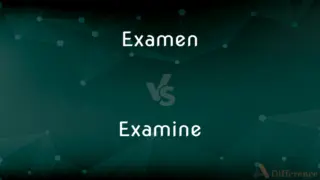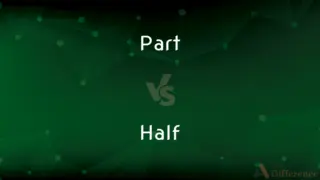Dactyl vs. Spondee — What's the Difference?
Edited by Tayyaba Rehman — By Fiza Rafique — Updated on April 19, 2024
Dactyl, a metrical foot of one stressed syllable followed by two unstressed, contrasts with Spondee's two consecutive stressed syllables.

Difference Between Dactyl and Spondee
Table of Contents
ADVERTISEMENT
Key Differences
A Dactyl is a three-syllable metrical foot with the pattern of stress on the first syllable, followed by two unstressed syllables. Whereas, a Spondee consists of two syllables, both stressed, often used to add emphasis or change rhythm in poetry.
In classical poetry, dactyls are commonly used to convey a sense of rapidity and movement. On the other hand, spondees slow down the pace, offering a dramatic pause or emphasis within the verse.
Dactylic meter is emblematic of epics and narrative poetry, creating a flowing, storytelling rhythm. Conversely, spondee is less common as a continuous meter but is strategically employed to accentuate specific moments or phrases.
The flexibility of the dactyl allows poets to mix it with other metrical feet for varied poetic effects. In contrast, the spondee’s uniform stressed pattern makes it more rigid but impactful when used sparingly.
In terms of linguistic texture, the lightness of the dactyl's two unstressed syllables often mirrors quick, dynamic action. In contrast, the heaviness of the spondee's stressed syllables can underscore solemn or important textual moments.
ADVERTISEMENT
Comparison Chart
Syllable Structure
Stressed, Unstressed, Unstressed
Stressed, Stressed
Common Usage
Narrative and epic poetry
Emphatic moments in poetry
Effect on Rhythm
Creates rapid, flowing movement
Slows down and emphasizes
Compatibility with Other Feet
Often mixed with other feet
Less commonly mixed
Emotional Connotation
Conveys action and excitement
Adds solemnity and importance
Compare with Definitions
Dactyl
Reflects a natural, spoken quality of language.
Dactylic words often appear in casual conversation.
Spondee
Used to provide emphasis and pause in poetry.
Poets use spondees to highlight significant phrases.
Dactyl
A metrical foot in poetry consisting of one stressed syllable followed by two unstressed syllables.
Consider the word beautiful, which exemplifies a dactylic rhythm.
Spondee
A metrical foot consisting of two consecutive stressed syllables.
Heartbreak is a perfect example of a spondee.
Dactyl
Used predominantly in classical and English poetry.
Homer's epics often employ dactylic hexameter.
Spondee
Rarely forms the basis of an entire poem but impactful in specific uses.
Spondees effectively slow down a poem's rhythm at key moments.
Dactyl
Contributes to a light, rhythmic pattern in verse.
The dactyl suits the lively pace of a narrative poem.
Spondee
Difficult to sustain over long stretches in verse.
Due to its intensity, the spondee is used sparingly.
Dactyl
Can be combined with other metrical feet for varied effects.
Many English poets blend dactyls with trochees or iambs.
Spondee
Adds weight and seriousness to the text.
Spondees often mark the climax of a scene in dramatic poetry.
Dactyl
A metrical foot consisting of one accented syllable followed by two unaccented, as in flattery.
Spondee
A spondee (Latin: spondeus) is a metrical foot consisting of two long syllables, as determined by syllable weight in classical meters, or two stressed syllables in modern meters. The word comes from the Greek σπονδή, spondḗ, "libation".
Dactyl
A metrical foot in quantitative verse consisting of one long syllable followed by two short syllables.
Spondee
A metrical foot consisting of two long or stressed syllables.
Dactyl
A finger, toe, or similar part or structure; a digit.
Spondee
(poetry) A word or metrical foot of two syllables, either both long or both stressed.
Dactyl
A metrical foot of three syllables (— ⏑ ⏑), one long followed by two short, or one accented followed by two unaccented.
Spondee
A poetic foot of two long syllables, as in the Latin word lēgēs.
Dactyl
A poetical foot of three sylables (m ă ă), one long followed by two short, or one accented followed by two unaccented; as, L. tëgmĭnĕ, E. mer`ciful; - so called from the similarity of its arrangement to that of the joints of a finger.
Spondee
A metrical unit with stressed-stressed syllables
Dactyl
A finger or toe; a digit.
Dactyl
A metrical unit with stressed-unstressed-unstressed syllables
Dactyl
A finger or toe in human beings or corresponding part in other vertebrates
Common Curiosities
How does the use of dactyls affect the rhythm of a poem?
Dactyls contribute to a quick, flowing rhythm, suitable for lively narratives.
What is a dactyl in poetry?
A dactyl is a metrical foot with one stressed syllable followed by two unstressed syllables.
Are spondees common in English poetry?
Spondees are less common as a primary meter but are used for emphasis in many poems.
What is a spondee in poetry?
A spondee is a metrical foot consisting of two stressed syllables.
Why are spondees used in poetry?
Spondees add emphasis and can create a dramatic pause.
What types of poetry feature dactyls prominently?
Dactyls are featured in narrative and epic poetry, like those of ancient Greece.
How does the structure of a spondee influence its use?
Its dual stressed syllable structure makes it ideal for emphasizing important words or phrases.
Can a poem be written entirely in dactyls?
Yes, poems like classical epics often use extended sequences of dactylic meter.
Can dactyls and spondees be mixed in a single verse?
Yes, mixing dactyls and spondees can vary the rhythm and impact of a poem.
What effect does a spondee have on the mood of a poem?
Spondees often heighten the emotional weight, adding solemnity.
Is there a visual way to represent a spondee?
A spondee can be represented by two consecutive long dashes (— —).
In what contexts are spondees most effective?
Spondees are most effective during climactic or notably serious moments in poetry.
How can identifying dactyls and spondees help in understanding poetry?
Recognizing these meters helps in appreciating the rhythmic and emotional nuances of the poem.
Is there a visual way to represent a dactyl?
Typically, a dactyl can be visually represented as a long dash followed by two short dashes (— ∪ ∪).
In what ways do modern poets use dactyls?
Modern poets use dactyls for their rhythmic flexibility and suitability for English speech patterns.
Share Your Discovery

Previous Comparison
Examen vs. Examine
Next Comparison
Part vs. HalfAuthor Spotlight
Written by
Fiza RafiqueFiza Rafique is a skilled content writer at AskDifference.com, where she meticulously refines and enhances written pieces. Drawing from her vast editorial expertise, Fiza ensures clarity, accuracy, and precision in every article. Passionate about language, she continually seeks to elevate the quality of content for readers worldwide.
Edited by
Tayyaba RehmanTayyaba Rehman is a distinguished writer, currently serving as a primary contributor to askdifference.com. As a researcher in semantics and etymology, Tayyaba's passion for the complexity of languages and their distinctions has found a perfect home on the platform. Tayyaba delves into the intricacies of language, distinguishing between commonly confused words and phrases, thereby providing clarity for readers worldwide.
















































